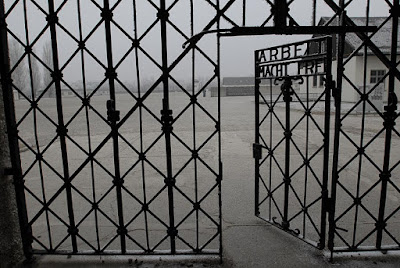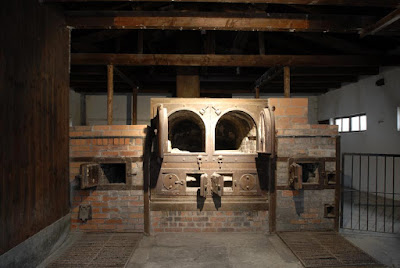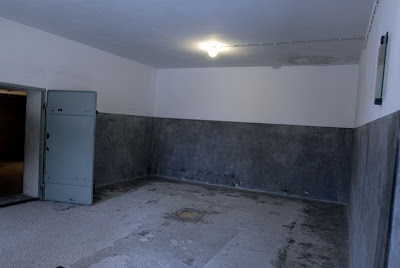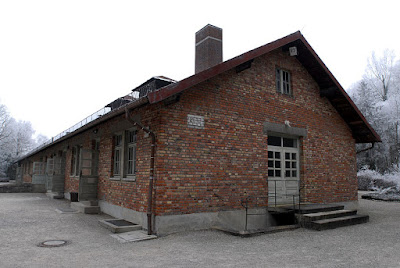The Dachau Concentration Camp
 Monday, December 24, 2007 at 3:27
Monday, December 24, 2007 at 3:27 "Arbeit Macht Frei": The Dachau Concentration Camp
22 December 2007
Words seem so weak and meaningless when I think about how to describe our visit to Dachau’s concentration camp Saturday.
Even that sentence seems trite and cliché – “Oh yeah, the Holocaust, sad, terrible, blah blah blah, we’ve heard it all before.” I recently wrote a paper about my Kristallnacht project and it begins like this:
“Ian Kershaw said, 'The road to Auschwitz was built by hate, but paved with indifference.’ The Holocaust is a topic most people prefer to know only superficially, or to ignore altogether. I believe that an understanding of its complexity, as well as its violence, is critical to an understanding of our world and our humanity”.
I believe this is how most people respond to or think when the topic of the Holocaust is brought up. Most Americans feel like they have "Holocaust Fatigue" (and you can imagine how the Germans feel).
It’s not that people don’t think that it was tragic and terrible; it’s that they don’t really understand how tragic and terrible it was and what that means to them today (i.e. losing personal freedoms and all those slippery political slopes we seem to find ourselves on lately). There is relevance and meaning in these events that we need to talk about and keep alive; both for the victims and for our own lives; politically and personally.
Munich (München) is about 200 miles southeast of us. It should be a little less than 3 hours to drive there. However, on Saturday, it took us over 4 hours because of “Staus” or traffic jams. Dachau is about 10 miles outside of Munich. It’s where the concentration camp is located and where we stayed.
When we arrived, we checked into the hotel and dropped off our (minimal) luggage. We stayed in nice place called Central Hotel Dachau. Denise was kind enough to pay for the rooms (thank you!) We only spent a few minutes in the room(s) and we were off to see the concentration camp. It was amazing to me that the camp was only 1.5 kilometers outside of the city! I was blown away! I thought about the crematorium and the ashes that must have fallen on Dachau, unbelievable.
It took less than 5 minutes to drive to the parking lot of the concentration camp (it’s weird to say that). We got out of the car and started unloading and getting dressed for the weather. Summer mentioned something about the smell. I could smell something like old onion soup and tin or metal. I thought it smelled kind of like body odor. She agreed and said that she was about to gag. Jean and Denise said they couldn’t smell it. We could smell it again outside of the barracks area. Later on, we realized that it got into our clothes (like smoke) and we could all smell it. It wasn't a good smell and we're not sure what it was.
It was very cold there Saturday – a damp cold. It was foggy and bleak too. The first time I realized that I was really there was when I saw that infamous, “Arbeit Macht Frei” slogan on the gate. What an insult this is – I could picture thousands of prisoners being marched in and out of that gate everyday to forced road marches, meaningless labor and ultimately death. That phrase must have haunted them.
The moment I walked through the gate, there was an eerie silence and expanse of space that was cold and gray. I immediately felt very alone. In fact, I felt an overwhelming sense of loneliness. I felt abandoned, scared and very small at that moment. I’m not easily spooked, but this place scared me in a weird, surrealistic way. It was very quiet. The only thing I could hear was the sound of my shoes crunching along the gravel with each step I took. I couldn’t feel my legs and I felt hollow, or outside of myself somehow. All of a sudden, a scene of isolation ran through my mind. I “saw” and “heard” static and then I “saw”, or felt, myself standing in a cold snow-drifted land with the wind rushing across my body. It was like a scene from a movie. I was standing at the far right of the frame facing the viewer and wind was blowing hard from my left. I just stood there looking into nothingness. The feeling of expanse, abandonment and loneliness never left me.
To go into details of what we saw wouldn’t do them justice. I even had second thoughts about writing anything about our trip. It’s safe to say that it was emotional and moving to be in a place where so many people lost their lives in such terrible ways.
For the first time in my life, I’m beginning to understand why it’s so important to remember. Why memory is so crucial to our progress. We truly are destined to repeat these kinds of things if we don’t. This is probably my favorite image I shot there. This beautiful red rose, covered in frost and dying, lying on a box of ashes of some of the victims of Dachau. The wall says, "Never Again" in five different languages. That is the message I got - to keep these memories alive. The stones are from Jewish people that have visited and placed a stone on the box of ashes as a symbol of erecting a tombstone for the dead.
This is probably my favorite image I shot there. This beautiful red rose, covered in frost and dying, lying on a box of ashes of some of the victims of Dachau. The wall says, "Never Again" in five different languages. That is the message I got - to keep these memories alive. The stones are from Jewish people that have visited and placed a stone on the box of ashes as a symbol of erecting a tombstone for the dead. The infamous gate - "Arbeit Macht Frei" - I will never think about that phrase the same way again.
The infamous gate - "Arbeit Macht Frei" - I will never think about that phrase the same way again. The plaque says, "Execution Range with Blood Ditch". There are a couple of these on the camp. Summer is placing stones on the memorial. The "blood ditch" is right in front of the plaque.
The plaque says, "Execution Range with Blood Ditch". There are a couple of these on the camp. Summer is placing stones on the memorial. The "blood ditch" is right in front of the plaque. A photo shot in 1945 right after the liberation of Dachau showing the remains of some of the victims. They could fit up to 9 bodies in these ovens. Nine people? Can you imagine how emaciated the people were?
A photo shot in 1945 right after the liberation of Dachau showing the remains of some of the victims. They could fit up to 9 bodies in these ovens. Nine people? Can you imagine how emaciated the people were? These ovens WERE USED to cremate people. This is in the "old" Crematorium.
These ovens WERE USED to cremate people. This is in the "old" Crematorium. 
In so many ways, this is what Dachau felt like to me. I was very moved by this memorial - "Crematorium - Remember How We Died Here"
I was very moved by this memorial - "Crematorium - Remember How We Died Here" The (very moving) sculpture in the center of the camp by the artist, Nandor Glid. The emaciated bodies entangled with barbed wire - It says, "Forgive, but never forget".
The (very moving) sculpture in the center of the camp by the artist, Nandor Glid. The emaciated bodies entangled with barbed wire - It says, "Forgive, but never forget". This is the ONLY color in the camp. It's a bas relief that shows the different "badges" worn by the camp's prisoners. Jews, A-socials (Gypsies), Homosexuals, Jehovah Witnesses, and Political and Religious prisoners all had different symbols and color combinations of symbols in order to quickly identify their "crimes". The piece is three links of chain connected by bars with the badges on/around each chain.
This is the ONLY color in the camp. It's a bas relief that shows the different "badges" worn by the camp's prisoners. Jews, A-socials (Gypsies), Homosexuals, Jehovah Witnesses, and Political and Religious prisoners all had different symbols and color combinations of symbols in order to quickly identify their "crimes". The piece is three links of chain connected by bars with the badges on/around each chain. Summer peering into the Jewish Memorial on the far south side of the camp.
Summer peering into the Jewish Memorial on the far south side of the camp. These were the victims found in the room I photographed below. This is just mind blowing to me!
These were the victims found in the room I photographed below. This is just mind blowing to me! This is the room where the (above) victims were piled up. It was cold and eerie. The whole thing was surreal.
This is the room where the (above) victims were piled up. It was cold and eerie. The whole thing was surreal. Jean and Summer peer through the window inside the (new) Crematorium.
Jean and Summer peer through the window inside the (new) Crematorium. The barracks - rebuilt in 1964. It was amazing how strict the SS was on the cleanliness and order of the barracks - just another testament to the sickness of it all.
The barracks - rebuilt in 1964. It was amazing how strict the SS was on the cleanliness and order of the barracks - just another testament to the sickness of it all. This is the "old" Crematorium directly across from the "new" one.
This is the "old" Crematorium directly across from the "new" one. Bodies in front of the "old" Crematorium (see photo above this) in 1945. Obviously, these victims were going to be cremated.
Bodies in front of the "old" Crematorium (see photo above this) in 1945. Obviously, these victims were going to be cremated. Detail of the (used) ovens in the "old" Crematorium.
Detail of the (used) ovens in the "old" Crematorium. Denise looking into one of the ovens of the "new" Crematorium.
Denise looking into one of the ovens of the "new" Crematorium. Electric fence and guard tower. I wonder how many died on these fences?
Electric fence and guard tower. I wonder how many died on these fences? Entering into the concentration camp at Dachau.
Entering into the concentration camp at Dachau. I'm at one of the "Execution Ranges with Blood Ditch". I wanted to stand there to see what it felt like. I was looking for bullet holes in the concrete.
I'm at one of the "Execution Ranges with Blood Ditch". I wanted to stand there to see what it felt like. I was looking for bullet holes in the concrete.
The "new" Crematorium and gas chamber building. 2/3 of all of the prisoners were non-Jewish, political prisoners with Polish Catholics in the majority. 1034 Catholic Priests died at Dachau. This is a memorial to them.
2/3 of all of the prisoners were non-Jewish, political prisoners with Polish Catholics in the majority. 1034 Catholic Priests died at Dachau. This is a memorial to them. This is a gas chamber that was used at Dachau. I could barely stand up in it - it freaked me out. I was amazed that I got this image with the moving body in it.
This is a gas chamber that was used at Dachau. I could barely stand up in it - it freaked me out. I was amazed that I got this image with the moving body in it. This is, "The Grave of Thousands of Unknowns" - the ashes from the Crematorium were dumped here (as well as other places).
This is, "The Grave of Thousands of Unknowns" - the ashes from the Crematorium were dumped here (as well as other places). A photo from 1945 showing the bodies of some of the victims piled outside of the Crematorium.
A photo from 1945 showing the bodies of some of the victims piled outside of the Crematorium. This is some of the train track just outside of the main gate.
This is some of the train track just outside of the main gate.
"Dachau can and shall be a lesson! Therefore we dare not be silent about it, although the memory of it is sad and grievous." Dr. Johannes Neuhäusler, Auxiliary Bishop of Munich and former Dachau inmate, June 17, 1960
 Quinn Jacobson | Comments Off |
Quinn Jacobson | Comments Off | 

